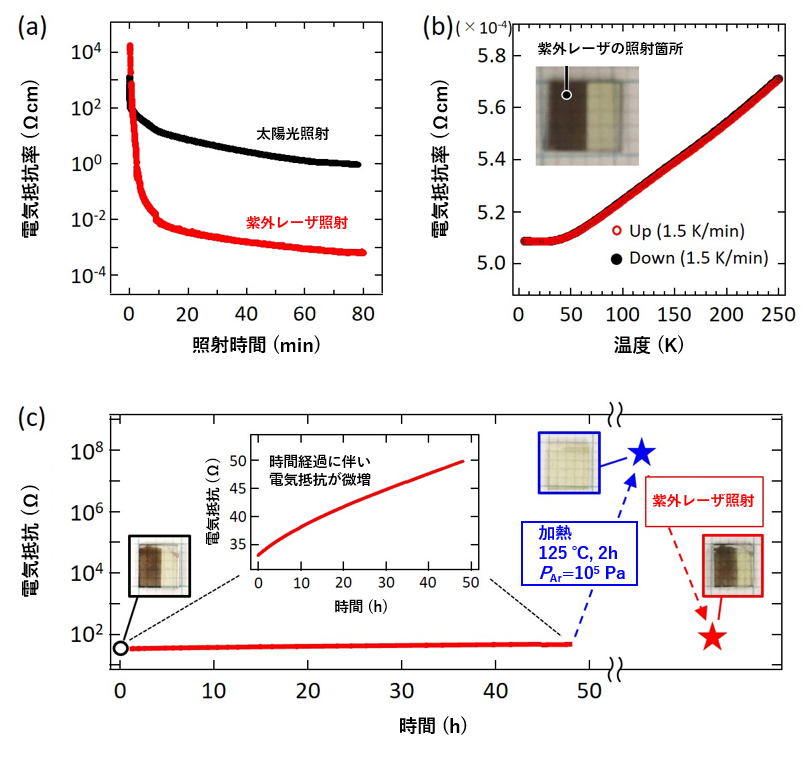DATE2022.04.07 #Press Releases
Back and forth between metal and insulator with light and heat
Disclaimer: machine translated by DeepL which may contain errors.
-World's First Photoresponsive Yttrium Compound Thin Film with High Performance
Tokyo Institute of Technology
The University of Tokyo
Japan Atomic Energy Agency
Japan Quantum Science and Technology Agency
Institute of Engineering Innovation
Summary
A joint research group led by Associate Professor Ryota Shimizu and Yuya Komatsu (second-year doctoral student) of the Department of Applied Chemistry, School of Materials Science and Engineering, Tokyo Institute of Technology, has successfully fabricated the world's first epitaxial thin film of a compound of yttrium, oxygen, and hydrogen ( YOxHy) with aligned crystal orientation, and demonstrated the repeated insulator/metal The company has succeeded in changing the crystal orientation between insulator and metal by light irradiation and heating.
For optoelectronic applications such as optical sensors and optical memory, it is desirable to develop materials whose electrical properties change significantly upon light irradiation. However, there has been no report of a change from "insulators/semiconductors," whose electrical resistance increases with decreasing temperature, to "metals," whose electrical resistance decreases with decreasing temperature, by photoirradiation. In this study, we succeeded in developing a "metallic" state in which the electrical resistance of an insulator YOxHyepitaxial thin film was significantly reduced by photoirradiation, and the metallic state was maintained for several days. Conventional polycrystalline YOxHy on glass substrates exhibits a one-digit decrease in electrical resistance upon solar irradiation, but the epitaxial thin film has achieved a decrease of more than three orders of magnitude. Furthermore, UV laser irradiation of the epitaxial thin film reduced the electrical resistance by more than seven orders of magnitude, achieving metallization from an insulator. To explain this result, a structural model was constructed based on high-resolution measurements of the local structure and chemical composition, and the electronic structure was calculated based on this model. As a result, the microscopic mechanism by which hydrogen in the thin film responds to light and produces excess electrons, leading to metallization was clarified.
The results of this research will lead to device applications such as high-performance optical memory and smart windows. Further progress in optoelectronics is also expected through advanced control of the density, bonding, and charge state of hydrogen in the thin film.
The research results were published online as an article in Chemistry of Materials, a journal of the American Chemical Society, on April 7 (open access).

Figure: ( a) Change in electrical resistivity of YOxHyepitaxial thin film due to solar irradiation (black) and ultraviolet laser irradiation (wavelength: 193 nm) (red). ( b ) Temperature dependence of electrical resistivity in YOxHyepitaxial thin film after UV laser irradiation (wavelength: 193 n m). Positive slope means metallic conduction. The inset shows the appearance of the thin film after UV laser irradiation (only the left half is irradiated). ( c ) Time dependence of electrical resistivity after UV laser irradiation. The electrical resistance slightly increases from 0-50 hours at room temperature and re-isolates upon heating to 125 °C for 2 hours. Furthermore, UV laser irradiation re-metalizes the electrical resistance. The inset shows the appearance of the thin film in each state.
Professor Shinji Tsuneyuki of the Department of Physics participated in the research results.
For more information, please visit the websites of The University of Tokyo and Institute of Industrial Science, The University of Tokyo.


